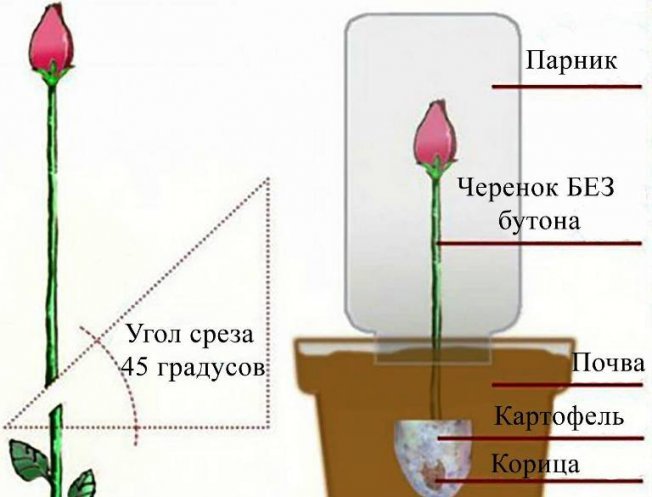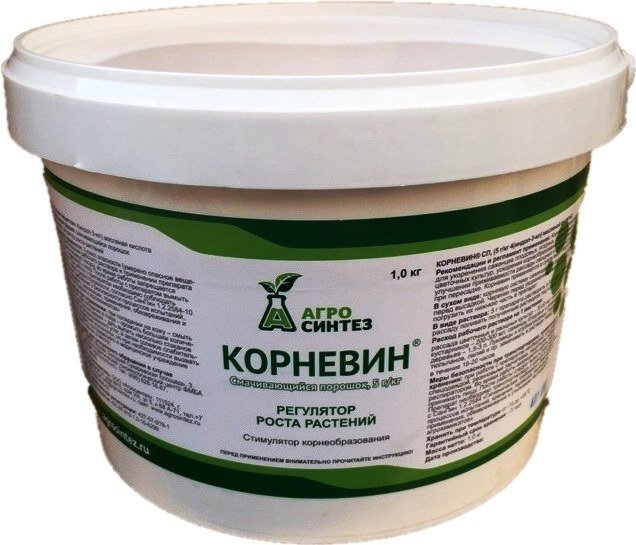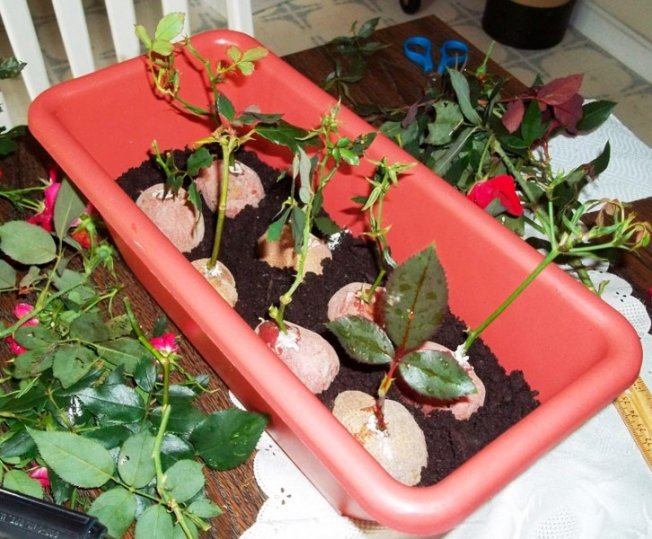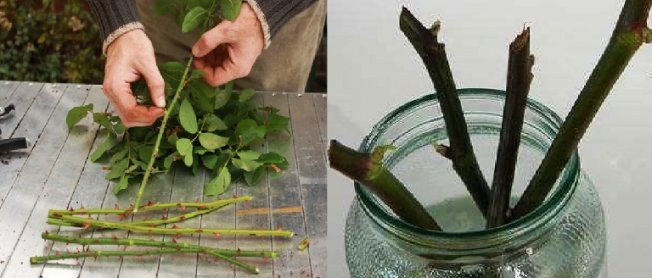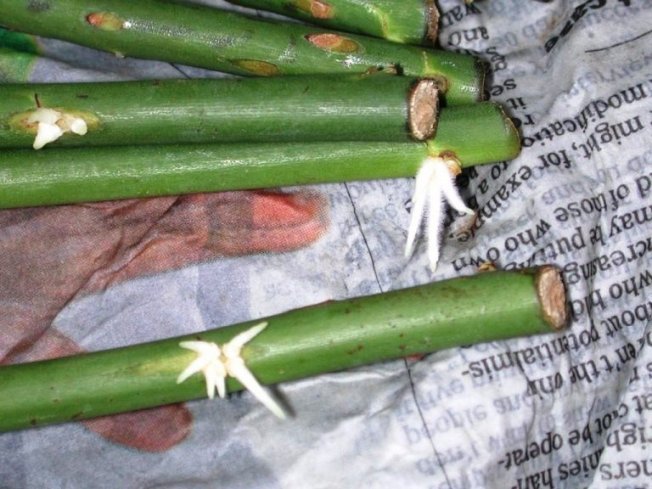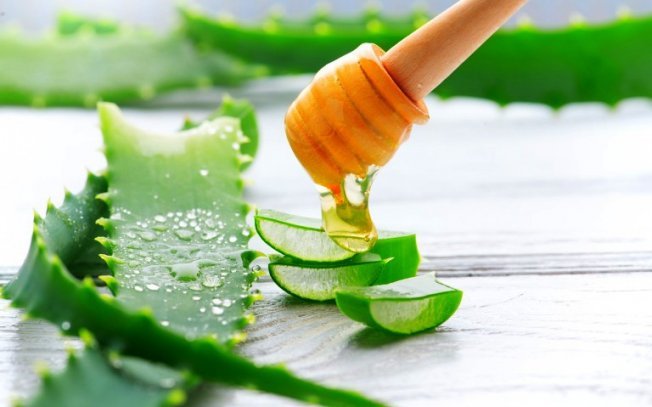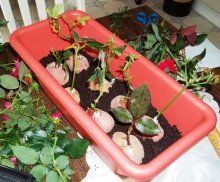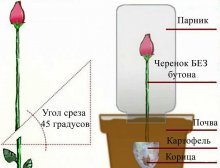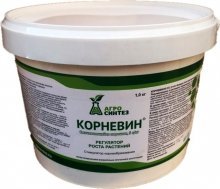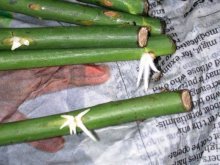How to grow a rose from a bouquet at home in winter: in potatoes, in water, in soil

Roses purchased at a flower shop amaze with their tenderness and beauty; you often feel the desire to decorate your summer cottage with the same wonderful flower. But here the question arises, how to grow a rose from a bouquet at home in winter, is it even possible to get a new plant from a cut bud.
Content:
- Which stems can produce roots?
- How to prepare a cutting for germination
- How to germinate a rose in winter using potatoes
- Rooting in winter in the ground, in a pot
- Rooting in water
- An interesting option is rooting in newspapers
- We use a magical remedy of aloe juice and honey
- Roses cannot be rooted - what is the reason?
- Puseful tips
- Planting rooted cuttings in open ground
Which stems can produce roots?
Experienced gardeners claim that it is not possible to germinate a root from every flower that is taken out of a bouquet.
You can place more hope on roses grown in the country of your residence; flowers imported from Ecuador, Holland or Kenya were grown in special conditions; during the industrial cultivation of flower crops in these countries, special fertilizers are used. In open ground conditions and without special care, it is unlikely to be possible to obtain healthy, full-fledged plants of these varieties.
Problems with the germination of Dutch flowers also arise for the reason that for long-term storage of marketable buds, they are treated with special chemical preservatives. A cutting taken from such a flower cannot germinate and, accordingly, it will not be possible to grow a bush either.
You should know that root formation is more active on cuttings obtained from red or white roses. As a result of selective breeding, it is almost impossible to germinate blue, orange or yellow flowers.
For germination It is recommended to use only fresh stems; the longer the buds stay in the vase, the less chance of successfully obtaining a new plant.
Talking about how to grow a rose from a bouquet at home in winter, we note that it is much more difficult to germinate stems in winter than in summer and spring; the activity of root formation depends on the season.
How to prepare a cutting for germination
It is advisable to choose a rose from a bouquet whose stem has already begun to become woody, i.e. acquired a greenish-brown color.
On the stem you need to find a segment with 3 buds located in a row. Above the top, stepping back 2-3 cm, cut the stem at an angle of 90 degrees. From the third bud we retreat down 1-1.5 cm and make a cut at an angle of 45 degrees. The longer part of the cut should be on the side opposite to the one on which the bud is located.
The bottom leaf is removed completely, the rest - by half, in order to reduce the consumption of nutrients. The prepared cuttings are placed in Kornevin solution for 24 hours. This is a special mixture of nutrients that stimulates the appearance of roots in plants. You can buy Kornevin at any gardening store.
It is also recommended to purchase a package of universal primer. You need to make drainage in the pot; to do this, you can put washed pebbles or pieces of polystyrene foam on the bottom. Water will not stagnate in the pot, and putrefactive processes in the soil will not develop.
After 24 hours you can start planting cuttings, here you will need to select one of the options.
Let's watch a useful video about how to grow a rose from a bouquet at home in winter, how to select and prepare a cutting.
How to germinate a rose in winter using potatoes
Medium-sized potatoes should be carefully removed to prevent sprouts from appearing. Next, a recess is made in it; for this you can use a kitchen knife. It is advisable to dip the planting material in dry Kornevin, then place it in the recess. It is recommended to use cuttings whose length does not exceed 20 cm.
Next, we bury the potatoes in the ground and water them with warm, settled water. Thanks to the potato, the cuttings receive:
- constant nutrition;
- protection from harmful microorganisms.
Next, we make a greenhouse using a cut plastic bottle. Next, we spray the stems with warm water every day, watering as the soil dries. Once a week, watering can be done with sweetened water.
Rooting in winter in the ground, in a pot
Choose a pot with large drainage holes. Fill it with substrate. You can use universal soil, or one intended for violets, or sphagnum moss. Next, we make a hole into which most of the cutting can be deepened, with the expectation that the lower bud should be below ground level.
Dip the lower cut of the rose in Konevin, or Heteroauxin, immerse it in the soil, and sprinkle it.
To prevent stem rot, it is recommended:
- make a solution of Fitosporin and spill the soil;
- Place 1 tablet of Glyocladin in the pot.
Next, in the same way as in the previous version, we make the simplest plastic greenhouse.
Rooting in water
This can occur if the cutting sits in a container filled with water for at least 2 weeks. The water will need to be changed daily; it is best to use distilled water. The material that is being prepared for germination is placed in a well-lit but cool place.
After the roots appear, the stem is planted in a pot filled with soil. If, over time, new buds appear on the cuttings, then the rooting process was successful. It is impossible to remove a seedling from the soil; replanting it is impossible.
An interesting option is rooting in newspapers
Sheets of newsprint are moistened, but not to such an extent that water flows from them or they come apart. The cuttings are completely wrapped in damp paper, possibly several sheets. Next, the bundles are placed in a plastic bag and tied, in order to obtain a greenhouse effect.
Keep the cuttings in a cool place. Newspapers are changed periodically, the main thing is not to allow them to dry out completely.
It is likely that after a couple of weeks, seals will form on the stems - the beginnings of roots. After this, roses can be planted in pots with soil.
We use a magical remedy of aloe juice and honey
You can stimulate the germination process using folk remedies. To do this you will need:
- put the aloe vera leaf in the refrigerator for a day, squeeze the juice from it (you need 1 teaspoon);
- 1 teaspoon natural honey;
- 1 teaspoon of wood ash;
- half a glass of water.
The components are thoroughly mixed, and the prepared cuttings are placed in the resulting solution for 12 hours. If the stems are very weak, the procedure time can be increased.
Next, the cuttings are planted in a pot with an earthen mixture and covered with a plastic bottle.
Roses cannot be rooted - what is the reason?
The main reason is in the varieties, some of them are distinguished by very thick (fatty) shoots of a reddish color and huge buds. They are the ones who almost always begin to rot; naturally, rooting does not occur.
In addition, experienced gardeners claim that hybrid tea and park roses are least suitable for propagation by cuttings. Root formation occurs much more actively in floribunda, climbing and groundcover plant varieties.
Greenhouse flowers that are grown for cutting are often fed with growth stimulants and fertilizers; they are too delicate and not adapted to survive in harsher conditions.
Useful tips
To increase your chances of getting a positive result, you need to consider that:
- Only fresh ones can be taken for cuttings;
- you should choose the middle part of the stem, not yet aged, with three living buds;
- the optimal length of the segments is 20 cm;
- The sprouted stems should be covered with a bottle or jar; the air in the room is too dry.
If the bouquet was received in winter, then you can use another option: save the selected stems until spring, but not sprouted. In this case, the prepared cuttings are buried in the ground, and a dry shelter is built on top, which could protect the planting material from frost.
To increase the chance of getting a plant of the desired variety, it is recommended to experiment with as many stems as possible.The success of a business does not always depend solely on the experience of the gardener; some cuttings turn out to be unsuitable for germination.
Let's see how roses from a bouquet are rooted; there are many useful tips for those who want to get a new bush.
Planting rooted cuttings in open ground
Experienced flower growers do not advise rushing to transplant into open ground. Planting a plant that has not yet matured will most likely lead to the death of the new bush; it will be too difficult for a plant with a still weak measles system to survive the winter.
It is recommended to place pots with rose seedlings in the basement or on a glazed balcony. It is advisable that the room temperature does not fall below +3 C. This will allow the bush to adapt to living conditions in the open air.
It is especially important to follow this recommendation if cuttings were carried out in spring and summer. In any case, you can plant new bushes in the soil only after making sure that it is strong enough. As for the planting period: it is better to plant and replant roses in April-May.
Bushes obtained by germinating cuttings will be less resistant to frost than grafted ones. Therefore, it is recommended to provide for the possibility of organizing high-quality shelter for the winter.
If seedlings of miniature roses were grown, they can be transplanted into large pots and then grown in an apartment.
It is quite possible to grow a rose from a bouquet at home in winter; we have discussed how to implement this very budget option. Of course, not all attempts will be successful, but by experimenting with different methods you can determine the best option.There is no need to give up after the first failures; long-term practice proves that in some cases it is possible to germinate even varieties imported from Ecuador.


